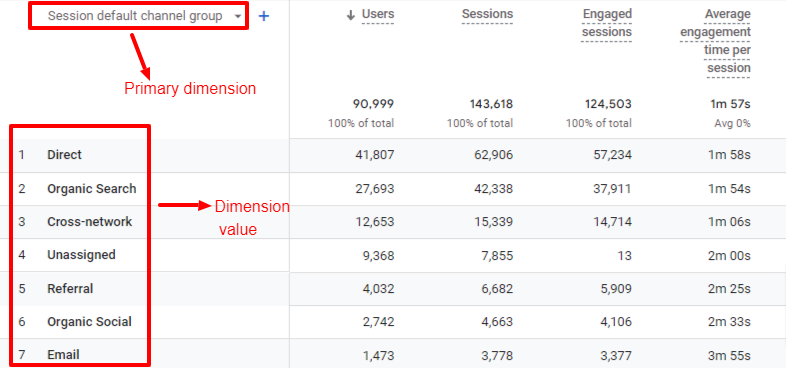Enhance Your Data Evaluation with Secondary Dimension in Google Analytics
Enhance Your Data Evaluation with Secondary Dimension in Google Analytics
Blog Article
Gain Thorough Point Of Views With Additional Measurement in Google Analytics
Second measurements in Google Analytics act as a powerful device for boosting the deepness of understandings acquired from information analysis. Stay tuned to uncover just how additional measurements can change your data evaluation and drive educated decision-making in the digital world.
Recognizing Second Dimensions in GA
Second dimensions allow customers to dive much deeper right into their data by including an additional layer of info to the primary data being analyzed. By including secondary measurements, individuals can segment and compare data across various measurements, such as traffic resources, individual tools, geographical places, and much more.
Comprehending just how to properly use secondary dimensions in Google Analytics is essential for removing valuable understandings from the information collected. By picking the appropriate additional dimensions to match key metrics, users can discover patterns, fads, and connections that might have otherwise gone undetected. This much deeper level of analysis can result in even more educated decision-making and the optimization of digital marketing techniques to improve total efficiency.
Benefits of Utilizing Second Dimensions
Exploring the advantages fundamental in leveraging secondary measurements within Google Analytics brightens the deepness of understandings offered for improving data analysis. By incorporating second measurements, individuals can gain a much more detailed understanding of their primary information metrics.
In addition, second dimensions enable customers to compare and contrast different data factors within the exact same record, supplying an extra alternative sight of site efficiency. This relative evaluation can lose light on the performance of advertising projects, material interaction, or user demographics. Additionally, the use of secondary dimensions can assist in determining outliers or abnormalities that may call for additional investigation.
Fundamentally, leveraging secondary dimensions in Google Analytics uses a powerful device for drawing out useful insights and maximizing data-driven decision-making processes.
Executing Second Measurements Effectively
To properly execute second dimensions in Google Analytics, planning the option and application of these added data layers is vital for maximizing the depth of understandings originated from analytics records. When selecting additional measurements, think about the certain goals of your evaluation to guarantee the picked dimensions line up with the info needed to answer essential questions. It's vital to prioritize relevancy over quantity, picking measurements that complement the key dimension and supply meaningful context.
Applying secondary measurements successfully involves using them to discover patterns, trends, and connections that may not be obvious when evaluating data only based on the primary dimension. By integrating secondary measurements thoughtfully, you can boost the granularity of your analysis and gain much deeper understandings right into user actions, content efficiency, and other key metrics within Google Analytics.
Studying Information With Second Measurements
Using secondary dimensions in data evaluation supplies a nuanced perspective that reveals detailed partnerships and patterns within Google Analytics reports. By including secondary measurements alongside key measurements, experts can delve much deeper right into the information to extract useful insights. This technique allows the identification of relationships that may not be immediately evident when analyzing information exclusively based upon primary dimensions.
When analyzing data with secondary dimensions in Google Analytics, it is necessary to consider the certain metrics or measurements that will offer the most meaningful context for the main dimension being examined. Matching the key measurement of 'website traffic resource' with second measurements such as 'gadget group' or 'touchdown web page' can supply an extra comprehensive understanding of user habits and preferences.
Moreover, the capability to sector data using second measurements permits for an extra granular assessment of individual communications, aiding his response in the optimization of advertising methods, website efficiency, and general individual experience. By leveraging secondary dimensions effectively, organizations can make enlightened choices based on a thorough evaluation of their Google Analytics information.
Finest Practices for Secondary Measurements
When implementing second dimensions in Google Analytics, precision in picking pertinent metrics is extremely important for acquiring actionable understandings from the information analysis procedure. Among the most effective methods for making use of secondary dimensions properly is to straighten them go to this site with your primary dimension to acquire an extra thorough understanding of your internet site or campaign performance. If your key dimension is 'Source/Medium,' pairing it with second dimensions like 'Tool Category' or 'Landing Web page' can supply understandings into just how different tools or touchdown web pages effect website traffic from various resources.

Frequently trying out with different combinations of secondary and primary dimensions can assist you find brand-new correlations and trends within your data, enabling you to enhance your techniques and boost overall efficiency (Secondary Dimension in Google Analytics). By following these best practices, you can leverage secondary dimensions in Google Analytics successfully to obtain much deeper insights and make data-driven decisions that positively impact your company

Verdict
In final thought, second dimensions in Google Analytics give a useful possibility to obtain deeper insights into main linked here information metrics. By including a secondary dimension to reports, services can discover correlations, fads, and patterns that might not be right away evident, bring about an extra comprehensive understanding of individual habits and interactions on a web site. Carrying out additional dimensions properly and evaluating information with them can assist organizations make data-driven choices and enhance their on the internet performance.
By incorporating additional dimensions, individuals can section and compare data throughout various measurements, such as web traffic sources, user devices, geographic locations, and more. Carrying out second measurements efficiently involves using them to reveal patterns, trends, and correlations that might not be noticeable when assessing information solely based on the key dimension. By integrating additional dimensions alongside key measurements, analysts can dive much deeper into the information to draw out valuable understandings. One of the finest techniques for making use of second measurements efficiently is to align them with your key dimension to obtain a much more extensive understanding of your web site or campaign efficiency. If your primary dimension is 'Source/Medium,' pairing it with second dimensions like 'Tool Classification' or 'Touchdown Page' can give insights into how various devices or touchdown pages effect traffic from various resources.
Report this page